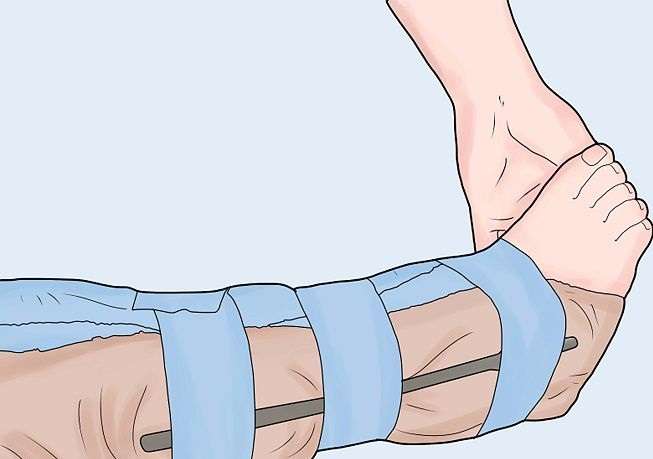First Aid In Fractures, Dislocations And Sprains
What Is Fracture?
Fracture is the deterioration of bone integrity. Fractures may occur as a result of an impact or by itself. The risk of spontaneous fracture increases with old age.
How Many Types of Fractures Are There?
Closed fracture: Bone integrity is impaired. However, the leather is sturdy.
Open fracture: Skin integrity is impaired. Broken ends can go out.
What Can Be Symptoms of Fracture?
Pain that increases with movement
- Deformity
- Loss of motion
- Bruising due to edema and bleeding
- Manual examination is required to detect painful areas.
What are the adverse conditions could lead to fracture?
Injury and compression of the veins, nerves and muscles near the fracture (inability to take a pulse in the area of the fracture, paleness, coldness)
- Shock due to bleeding in comminuted fractures. How Should First Aid be in Fractures?
- Life-threatening injuries are prioritized.
- The patient / injured is not moved, but kept warm.
- If the arm is affected, items such as rings and watches are removed (otherwise the edema that may develop will cause tissue damage).
- Fingers are left exposed while fixing and coiling. Thus, color, movement and sensitivity in the fingers are controlled.
- The area with suspected fracture is determined by avoiding sudden movements, including the lower and upper joints. Fixing materials should be made of hard materials such as sticks, wood, cardboard and should be long enough to contain the upper and lower joints of the broken bone.
- In open fractures, the wound should be covered with a clean cloth before fixation.
- Pulse, skin color and temperature are checked frequently in the broken area.
- Arms and legs are kept up.
- Seek medical assistance.
What is a Sprain?
It is the instant separation of the joint surfaces. It occurs as a result of compulsion.
What are the Symptoms of Sprain?
- Pain in the area of the sprain
- Redness, swelling
- Loss of function
How Should First Aid Be Done in Sprain?
- The sprained joint is detected with a compression bandage.
- The area is lifted up to reduce swelling.
- Cold application is made in the early period.
- It is not moved.
- Seek medical assistance
What is Dislocation?
It is the permanent separation of joint surfaces. It cannot return to its normal position by itself.
What are the Symptoms of Dislocation?
- Intense pain
- Swelling and redness
- Loss of function
How Should First Aid Be Done in Dislocation?
- The joint is fixed exactly as it is located.
- The dislocation is not tried to be settled.
- Nothing is given by mouth to the patient / injured person.
- Pulse, skin color and temperature in the area are checked.
- Seek medical assistance
How Should be Fixation in Fractures-Dislocations and Sprains?
First aid uses available materials for detection. These are triangle wrap, roll wrap, blanket, cardigan, scarf, tie, etc. soft materials and wood, cardboard, etc. may be hard materials.
What are the Points to Consider During Detection?
- During fixation, the injured area should be kept constant.
- The wound should be covered with a clean cloth, if any.
- The area to be detected should be covered with soft material first.
- The injured area should be determined as it is. Correction should not be attempted.
- Detection; The fracture should be made to include the joints above and below the dislocation and sprain area.
Detection of Arm and Collarbone Fracture
- Soft material is placed under the armpit.
- Arm sling is placed.
- The triangle bandage is placed on the body of the casualty, with the top of the triangle on the elbow side, with the base in line with the body.
- Placed on the lower part of the chest with the hand bent at the elbow level. The two ends of the triangle bandage are tied around the casualty’s neck. The fingers of the detected hand should be visible.
- Arm sling support is placed over the chest cavity and injured arm (can be placed in a wide outer bandage). In this way, the injured arm and shoulder joint are fixed to the body.
Detection of Upper Arm Bone Fracture
- Made with hard fixing material.
- Before the materials to fix the broken bone are placed, two fabric strips are placed under the arm (using the seat space).
- The shorter of the materials is placed starting from the armpit so that it covers the elbow.
- The long one is placed so that it covers the shoulder and the elbow.
- It is fixed by connecting with previously placed strips. Strips should not be tied too short.
- Arm sling is attached to fix the elbow.
- A wide fabric strip or triangle bandage is applied over the chest and injured arm for shoulder fixation.
Elbow Fracture and Dislocation Detection
- If the arm is stretched, it is fixed to the body by putting soft filling materials between the arm and the body.
- If bent, it is fixed with an arm sling support .
Forearm, Wrist and Hand Fixation with Arm Sling
- A triangle arm sling is placed under the injured forearm to prevent movement of the broken elbow and wrist joint. The two ends of the triangle are knotted behind the neck of the patient / casualty.
- In order to prevent excessive movement, it is wrapped over the hanger and attached to the body with the help of a wide bandage.
Fixation with Hard Materials in Elbow and / or Forearm Bone Fractures
- 2 strips are placed under the forearm.
- One of the hard fixing material supported with soft material, from the bottom of the fingers to the elbow; the other is determined by placing the hand from the outer side of the hand to the elbow.
- It is tied with previously placed strips, it should not be over tightened.
- Arm sling is attached to fix the elbow joint.
- It is sufficient to fix the wrist bones or comb of the hand with an arm sling.
- It is difficult to distinguish between finger bone fractures and dislocations. For fixation, a fixation material and the injured finger can be bandaged with the healthy finger next to it.
Detection of Pelvic Bone Fracture
- A filling material is put between both legs.
- An eight-shaped bandage is used to fix the wrists.
- Secured by sliding the bandages under the natural gaps (knees and ankles) and knotting two between the hips and the knees, and the other two between the knees and ankles. All nodes must be on the same side.
Thigh Bone Fracture Detection – Detection using rigid fixation material and intact leg ( such as a second fixation material )
- One hand on the top of the foot; the other is placed on the wrist, grasping the injured leg and pulled gently to bring it into line with the intact leg. It is also applied in a slight twist.
- A padding is put between both legs (especially knees and ankles).
- The wrists are fixed with an eight-shaped bandage.
- 7 fabric strips (or similar) are passed underneath the casualty’s body, behind the waist, knees and wrists, using natural gaps without moving.
- Hard fixing material, supported by soft material, is placed from the armpit to the feet and tied up at the feet.
- Knots are thrown over the fixing material and bandages are tied.
- The wrist-level bandage is tied in a figure eight over the previous one.
- If there is no hard fixation material, it is fixed with wide bandages using the intact leg as a single support.
Knee Cap Fracture Detection
- The kneecap is determined by combining the two legs with the help of wide bandages. Care should be taken when tightening the bandages above and below the knee.
- If there is a wide and hard fixation material (plate), a plate is placed under the injured leg from hip to foot. Two of them are tied with wide bandages in the area between the hip-knee and two in the area between the knee-ankle and are wrapped with an eight-shaped bandage over the joint to stabilize the joint.
Fracture Detection for Flanks Same as for femur fracture.
- The legs are grabbed and pulled gently.
- Using natural gaps (below the knees, below the ankles) fabric strips are placed under the injured leg.
- One of the fixation material, which is appropriately supported with soft padding, is placed from the groin to the foot on the inside and from the hip to the foot on the other side.
- Starting from the feet, the straps are tied by knotting on the outer fixing material. The ankle bandage is knotted on the sole of the foot in the shape of eight.
Detection of the Ankle / Foot
- The casualty’s ties are undone without removing their shoes.
- Both feet are fixed together with an eight-shaped bandage wrapped at ankle level. It is necessary to keep the legs up by resting them on a surface well covered with soft materials (a rolled blanket).

